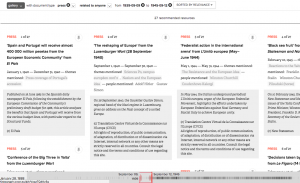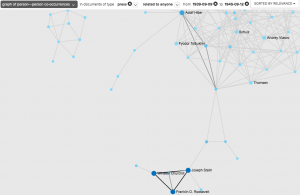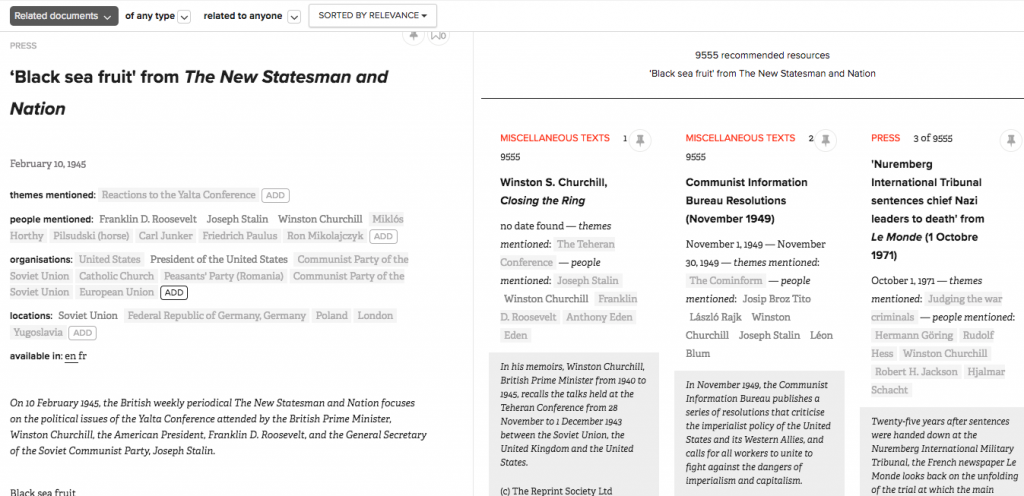Histograph offers interesting and informative way to find connections between people across time and space. It uses multimedia collections as networks, operating under the assumption that people mentioned in the same document must have some sort of connection. By operating under various parameters, Histograph visualizes the “network” of connections between different documents.
This tool could be useful for the digital humanist as a way to find primary media sources about specific relationships. It could also be used to see how events, places, and people overlap in time. A potential downside of this tool is that any mention of two keys (theme, location, place, or person) in a multimedia document is counted as a connection. In this way, Histograph allows a user to cast a wide net for primary sources and connections, but requires patience to sort through the documents for evidence of a deeper/more prevalent connection. Histogram also features a timeline that allows users to select from specific periods of time. While Histograph’s timeline goes back to 1888, most of the documents come from the last 60 years. As a tool, Histogram could be a great starting point for a digital humanist focused mainly on the 20th or 21st centuries.
Example Tutorial: Finding Person to Person Connections In Press Media During World War II
Histograph is fairly intuitive, but does not offer much in terms of starting points. For the sake of this tutorial, I decided to look at mentions within Press media during the second World War. Additionally, the order of steps in terms of searching for resources can be fluid; this tutorial outlines the process I went through to find my specific resources.
Getting Started: Histogram is free and requires a simple sign-in with a Google or Twitter account.
Step 1: Choose a time period
I started with selecting a period from the timeline along the bottom of the page. The selection tool for the timeline uses the mouse, and is limited to one date each month.
Step 2: Choose a document type
The scrolling dropdown menu provides a wide variety of options for different kinds of media. This is an effective way to narrow down the available resources if you are looking for a specific kind of media.
Step 3: Looking At Raw Resources and the Visualized Network
The home site of Histogram is just the gallery of resources, so to just look through specific resources, you don’t have to do anything past this point. However, if you are looking for something more specific (or are looking for connections between people), a good place to go is the person-person connection graph.
I found it interesting that the trio of Winston Churchill, Joseph Stalin, and Franklin Roosevelt were so separated from the rest of the network. Additionally, the edges connecting those three were particularly dark, indicating more resources that they were mentioned in.
Step 4: Finding Connecting Documents Between People
Selecting any of the connections in the network brings up a sidebar with information about the two. You have the option to pin any key that you bring up to your pinboard for later use. Additionally, the Ego Network option re-arranges the visualization centered around that particular person. Below the information are the primary resources that mention both Stalin and Roosevelt (in this case).
Step 5: Reading a Resource and Finding Additional Resources
Selecting any of the resources above sends you to that resource’s page, where a (if need be, translated) synopsis and full text of the resource are available to read. On the other side of the page are recommended resources based on the tags and information in the selected document, allowing for further exploration.
Histogram is a very expansive and powerful tool for finding connections through primary resources. In this particular occasion, all four documents that connected Joseph Stalin, Franklin Roosevelt, and Winston Churchill were in relation to the 1945 Yalta Conference to discuss the fate of postwar-Germany and the second of three major wartime conferences between the “Big Three.”




